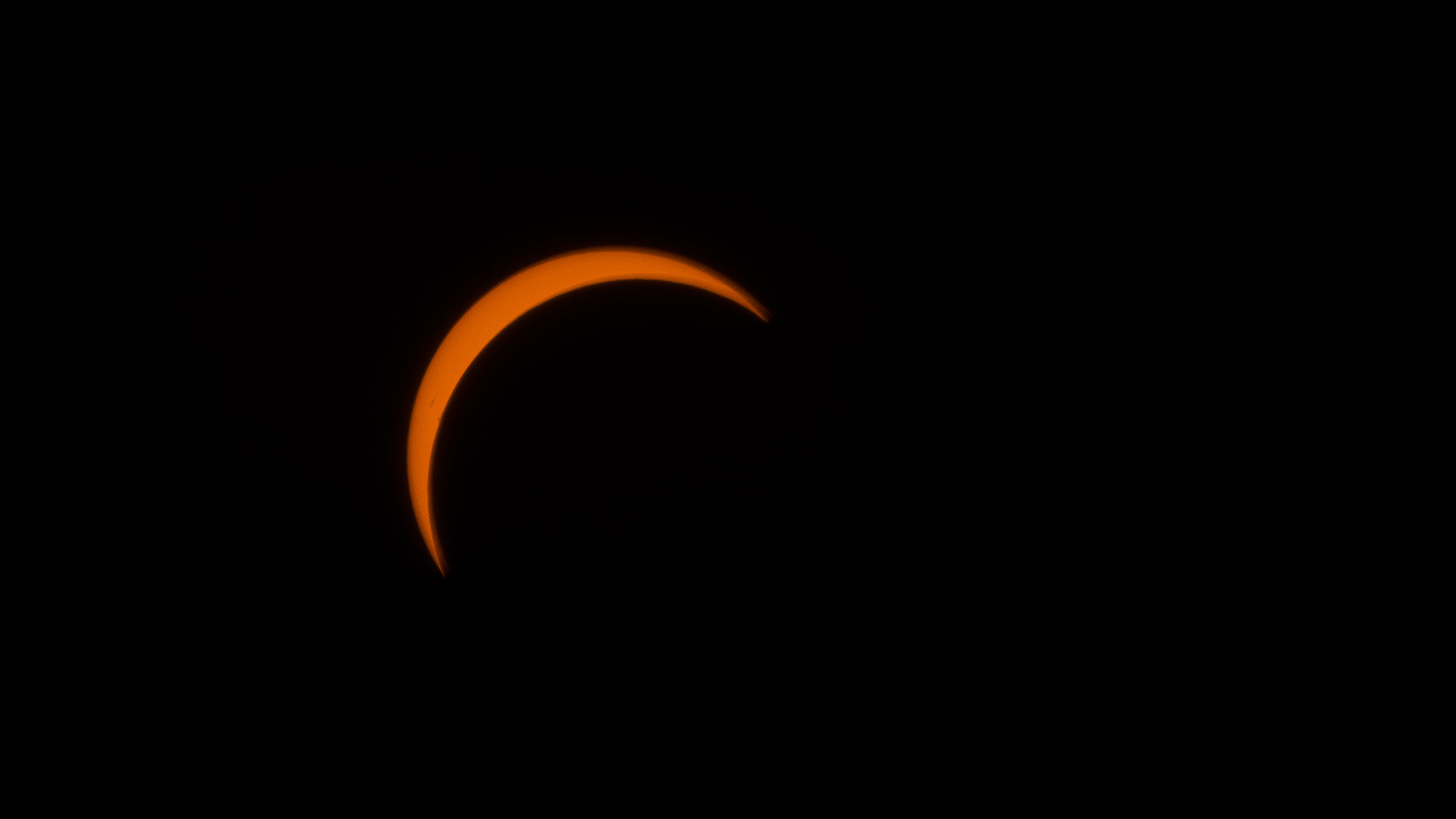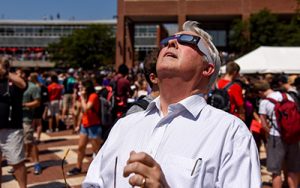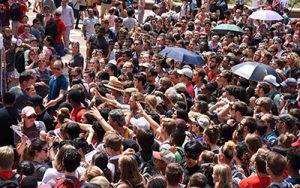Eclipses Have Shadowed NC State Before

Including Monday’s Great American Solar Eclipse, NC State has seen five significant solar eclipses during its first 130 years.: in 1900, 1918, 1970, 1984 and 2017. There will be two more over the next quarter-century, in 2024 and 2045, that scooch by neighboring states and one on May 11, 2078, in which Raleigh will be directly in the path of totality.
Like Mark Twain and Halley’s Comet, NC State was born under rare skies—two 19th-century eclipses, the first on Aug. 19, 1887, the year the school was founded; and another on Jan. 1, 1889, the year the school opened. Neither was visible in Raleigh.

On May 28, 1900, however, the scientific world descended en masse on North Carolina to witness one of the most important total solar eclipses in modern history, as scientists finally captured on film the existence of the solar corona, a “crown” that can be detected only during a full eclipse.
George Tayloe Winston, the president of tiny North Carolina State College of Agriculture and Mechanic Arts, joined with the Raleigh Board of Aldermen to invite scientists and government officials from all over the world to view an eclipse that had a projected 100 percent totality of coverage in the state.
They dispatched local businessman John C. Drewry to Washington to offer a place on the developing campus to view the eclipse. “It is the desire of the committee to also acquaint foreign scientists, who will visit this country, with the superiority of Raleigh as a point of observation,” according to Raleigh’s Morning Post on March 4, 1900.
Most, however, chose not to attend.
Instead President William McKinley viewed the event in Norfolk, Virginia, while celebrated scientists from the Smithsonian Institute, Princeton, Harvard, the University of Chicago, Johns Hopkins and universities in Canada, England, the Netherlands and Germany took literal trainloads of modern equipment to the tiny town of Wadesboro, North Carolina, to watch the event.
They chose that Anson County town, about 115 miles southwest of Raleigh and 50 miles east of Charlotte, to be the epicenter of science because it had historically better weather on that date than any other town in the path of totality. Congress appropriated $5,000 to set up a makeshift observatory near downtown Wadesboro.
Professors Samuel Pierpont Langley and Charles Augustus Young, two of the founders of modern astronomy, were there, as were others who hoped to capture the first glimpses of the suspected planet Vulcan, which was thought to be between Mercury and the sun. Venus and Mercury were visible, but no one ever saw Vulcan.

Langley brought 40 assistants, including Smithsonian photographer Thomas W. Smillie, with him to capture the eclipse. Among the equipment they shipped to Wadesboro was a 135-foot camera with a 12-inch diameter lens, a 61.5-foot telescope and crates of 25-by-30 glass photographic plates.
Three prominent professors from the North Carolina University in Chapel Hill attended, along with others the Yerkes Observatory and the Charleston Military Academy.
But Raleigh had a perfect, cloudless day and nearly two minutes of darkness. Wadesboro had just 91 seconds of total darkness.
“There was not a cloud in the sky, and the eclipse could be seen perfectly in Raleigh,” reported the Farmer and Mechanic magazine in its May 29, 1900, edition. “It was a beautiful sight — weird, unearthly and solemn. No man could witness it and doubt the existence of God.”
Some scientific dignitaries did observe the eclipse from Raleigh, which was in the path of totality. John K. Reese, the head of the astronomical department of Columbia University, and several of his colleagues observed the eclipse in Raleigh along with faculty of A&M College. Dozens of faculty and students from Durham’s Trinity College paid 75 cents for a special train to Raleigh to view the eclipse.
Perhaps it was just as well that a big crowd of scientists did not attend: A&M College was in the midst of its three-day commencement exercises, with a baccalaureate sermon at First Baptist Church, an alumni reunion, a board of trustees meeting and the commencement speech for the graduating class of 23 students. The speaker was a renowned scientist, however: Johns Hopkins professor (and later president) Ira Remsen, the chemist who was the co-discoverer of the artificial sweetener saccharin.
Much like Monday’s event, the 1900 eclipse was well publicized and much anticipated. Raleigh schools delayed their opening until 10 a.m. so students could learn about solar science. They were told not to view it through telescopes or opera glasses, but instead use the naked eye.
The most interesting visitor to the capital city was George C. Rounds of Manassas, Virginia, who had served as Gen. William Tecumseh Sherman’s signal officer during Raleigh occupation at the end of the Civil War. He asked, and was afforded, the opportunity to view the eclipse from his old post, where he used to watch over the capital city in the final days of America’s deadliest conflict.
He was one of dozens of people who watched it from the top of the Capitol dome.
Wartime Eclipse
The year 1918 could not have been more tumultuous at the newly named North Carolina State College of Agriculture and Engineering. America was at war, and the school had been turned into a military college, with all of its students conscripted into service. There was much less anticipation for an annular solar eclipse on June 8. In fact, State College cadets were in the midst of fire drills and an all-campus color guard presentation that Saturday morning.

Hundreds of people viewed the eclipse in downtown Raleigh, however, using self-smoked glass to protect their eyes from sun’s blood-red hue.
“It may be made by holding a piece of window glass over the fumes from burning pine,” read The Raleigh Times. “If the glass is not sufficiently darkened, the glare of the sun may injure the eyes, while too much of the burning pine will entirely cut off the light. The adjustment of the glass can be affected, however, by testing it from time to time, with due caution, before taking a direct view of the sun.”
The eclipse was the last to pass over the entire North American continent, though the path of totality did not go over North Carolina. At 7:33 p.m., the height of the eclipse, 82 percent of the sun was covered in Raleigh’s skies.
That day, the U.S. Army announced a total of 106 American casualties in the European war, including 30 killed in action and 10 killed in training.
Less than two months after the eclipse, NC State’s campus was hit by the worldwide Spanish flu pandemic. Of the 450 cases of the “Spanish Lady” reported on campus, 11 students and two nurses — including the daughter of school president W.C. Riddick — died from the flu. Campus was quarantined and all extracurricular activities were shut down, cancelling five games of the football season. When play resumed, the State College Farmers lost to Georgia Tech 128-0 in Atlanta.
In all, more than 13,000 North Carolinians died during the 18-month outbreak.
Championship Eclipse
On March 7, 1970, NC State faculty and students were split between two grand events: a party at East Carolina’s Ficklen Memorial Stadium directly in the path of totality of an afternoon eclipse and the ACC men’s basketball tournament championship game between NC State and South Carolina in Charlotte.
In Greenville, which had 100 percent coverage of the sun by the moon, about 4,000 people gathered in the stadium to watch the 1:30 p.m. event, including hundreds who left a dense fog covering Raleigh early that morning.

Four planets peeked through the stars in the darkness, as the crowd stood in silence for the entirety of the two-minute, 13-second eclipse. As it ended and full daylight was restored, someone blasted the Beatles’ 1969 hit song Here Comes the Sun on a small tape player.
In Charlotte, where some 95 percent of the sun was blocked from view, Norm Sloan’s basketball team took a slow approach to beat top-seeded and third-ranked South Carolina in the Saturday night title game. Gamecock All-American John Roche suffered a sprained ankle in the previous night’s semifinal and was hobbled throughout the championship game.
With 20 seconds remaining and the Wolfpack leading by one, NC State sophomore Ed Leftwich stole the ball from South Carolina guard Bobby Cremins, ending the Gamecocks’ chance at a comeback. Two free throws by Paul Coder sealed a 42-39 victory in one of the biggest upsets in tournament history, a game in which the planets — or at least the moon — were clearly aligned in the Wolfpack’s favor.
“To be honest, I have no recollection of there being an eclipse that day,” says tournament most valuable player Vann Williford.
The celebration on Raleigh’s Hillsborough Street lasted more than two days, a much longer span than the eclipse in Greenville.
Diamond Necklace Eclipse
An annular eclipse—one in which the moon is slightly smaller than the diameter of the sun, creating a necklace of light around it— traveled straight up the Interstate 85 corridor through North Carolina, casting a long shadow in the western part of the state and about 80 percent coverage of Raleigh.
However, much of North Carolina and Virginia was disappointed with the event, as heavy clouds covered the afternoon skies, obscuring the view of the 80 percent eclipse.
- Categories:


